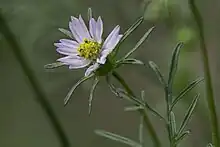| Cosmos parviflorus | |
|---|---|
 | |
| Scientific classification | |
| Kingdom: | Plantae |
| Clade: | Tracheophytes |
| Clade: | Angiosperms |
| Clade: | Eudicots |
| Clade: | Asterids |
| Order: | Asterales |
| Family: | Asteraceae |
| Genus: | Cosmos |
| Species: | C. parviflorus |
| Binomial name | |
| Cosmos parviflorus (Jacq.) Pers. | |
| Synonyms[1] | |
| |
Cosmos parviflorus, also known as southwestern cosmos, is a species of plant in the family Asteraceae found in North America.[2] In many places it is a common weed in agricultural fields, although it also grows in grassy meadows in forested areas. The species appears to be native in Texas, New Mexico, Colorado, Arizona, and Utah. Collections have also been made from Massachusetts, Maine, Maryland, Missouri, Rhode Island, although it appears to be introduced to those regions.[3][4] It is widespread in Mexico from Chihuahua to Oaxaca.[5][6][7][8]
Description
Cosmos parviflorus attains a height of up to 100 cm (40 inches). Leaves are deeply divided into narrow linear segments. Ray florets red, pink or white, the colors sometimes mixed in the same population. Achenes are barbed, causing them to lodge in fur or clothing. They can thus be transported over long distances.[3][9][10]
References
- ↑ The Plant List Cosmos parviflorus
- ↑ "southwestern cosmos (Cosmos parviflorus)". iNaturalist. Retrieved 2023-11-30.
- 1 2 "Cosmos parviflorus in Flora of North America @ efloras.org". www.efloras.org. Retrieved 2023-11-30.
- ↑ Biota of North America Program 2014 county distribution map
- ↑ "Southwestern Cosmos maps - Encyclopedia of Life". eol.org. Retrieved 2023-11-30.
- ↑ "Tropicos". www.tropicos.org. Retrieved 2023-11-30.
- ↑ García-Mendoza, A. J. & J. A. Meave. 2011. Diversidad Florística de Oaxaca: de Musgos a Angispermas 1–351. Universidad Nacional Autónoma de México, Ciudad Universitaria
- ↑ SEINet, Southwest Biodiversity, Arizona Chapter, Cosmos parviflorus includes description, photos, distribution map
- ↑ Loughmiller, C. & L. Loughmiller. 1984. Texas wildflowers: a field guide. Austin, Texas: University of Texas Press.
- ↑ Wiggins. Vegetation and Flora of the Sonoran Desert. Stanford University Press, 1964
External links
